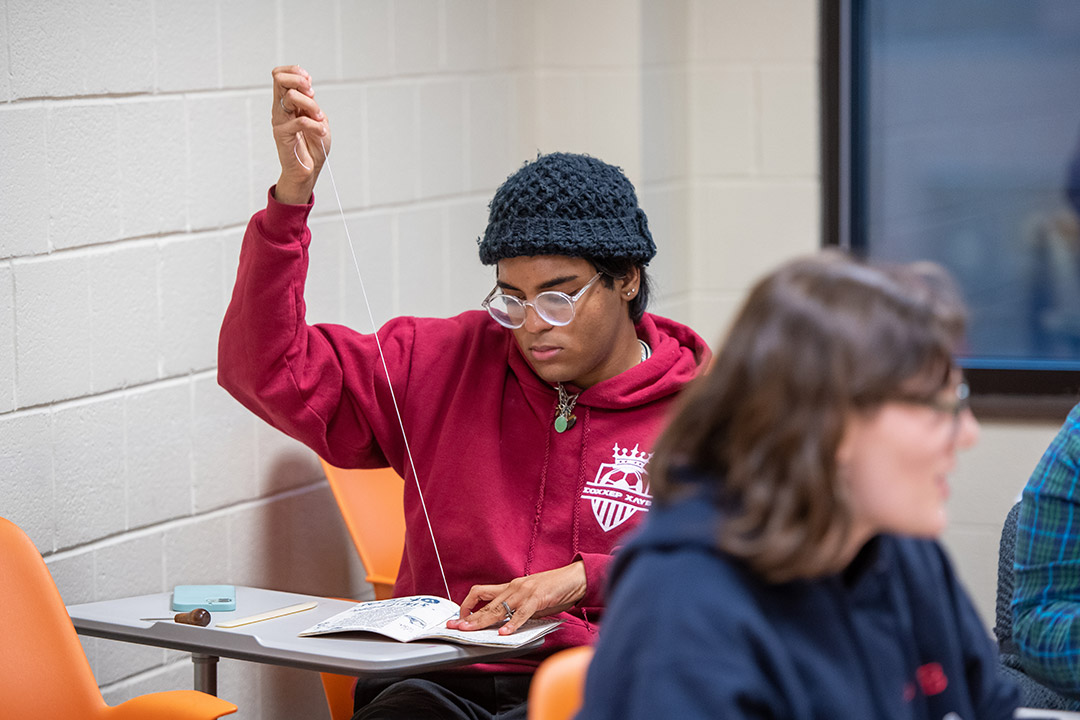Students create publication that transforms a deadly weapon into a tool for social advocacy
Students collaborate to create ‘Gun Ink Zine’ printed with ink made from recycled firearms
Carlos Ortiz
“Gun Ink Zine” is the result of a class-wide student collaboration. The zine comprises personal essays about students’ thoughts, opinions, and experiences relating to gun violence.
When creating art aimed at fostering social change, the method of delivery can be just as impactful as the message being shared. Students enrolled in an Opinion Media course this fall showcased this through a class project, where they created a collaborative zine about gun violence that was printed with ink made from recycled firearms.
Carlos Ortiz
Oritro Karim, a fourth-year illustration student, works a needle and thread through the pages of one of the zine copies. In addition to creating the content for “Gun Ink Zine,” the students also helped hand-sew the bindings of the zines.
Professor Hinda Mandell, who teaches the course, said she first got the idea for a project of this nature in 2022.
“I came across an article in American Craft magazine that spotlighted an ink maker named Thomas Little. It was a profile on why he turns firearms into ink, and it stuck with me because I thought it was so symbolically powerful,” said Mandell. “About a year later, I brought the idea of purchasing his ink for a student writing project to the director of the School of Communication, Tracy Worrell, and she was fully supportive of this idea to unleash creativity in service to students writing about and fostering social change.”
Opinion Media, a course offered through RIT’s journalism program, aims to help students improve their persuasive writing skills, with a particular focus on writing op-ed news articles. As part of the collaborative zine project, students were tasked with writing a persuasive personal essay on the topic of gun violence to exercise their skill at opinion-based writing.
What's a zine?
Zines—which are loosely defined as small-circulation, self-published mini-magazines—have long existed in alternative subcultures. In recent years, a growing number of RIT students, staff, and faculty across campus are using this unique medium to express themselves and communicate ideas. Read more about RIT's zine scene.
Each student contributed their personal essay to the zine, titled “Gun Ink Zine,” and some students contributed other visual elements to further breathe life into the publication. After compiling their work, the zine was printed by Rathaus Press, a local LGBTQIA+ Risograph studio and publisher.
Some of the thematic ideas that emerged from the students’ essays ranged from the seeming inevitability of gun violence in schools, to the oddly mundane practice of conducting active shooter drills, to the consequences and reverberations of neighborhood gun violence.
Hailey Fowler, a third-year journalism and advertising and public relations student, drew on her childhood experiences with gun violence to write her essay. Fowler grew up in Wallingford, Conn., a town just under 30 miles away from Sandy Hook Elementary School, the site of a mass shooting that killed 26 people in 2012.
“I was in the same age group and even shared the same phone number area code as the families of the children who passed away. My school went into lockdown for a couple of hours when it happened, and then they just sent us home because they didn't really know what to do with us,” said Fowler. “So I wrote about that experience and what it was like being in fourth grade as the Sandy Hook shooting happened.”
Sharing such personal thoughts and opinions in a classroom setting requires an abundance of vulnerability and necessitates a willingness to discuss difficult and often trying topics. Mandell said that making space in the classroom for her students to express their thoughts and experiences regarding topics like gun violence shows respect to them and the lives they’ve lived. She said it also helps to give students confidence regarding their authority and ability to write about such topics.
“I think it’s of critical importance that students learn how to tell their own stories, and the stories of their communities, in a written way that is clear, succinct, and organized in a compelling manner,” said Mandell. “By disengaging and pulling back from sensitive subject matter, we’re not really meeting students where they are. I have found it to be very rewarding to open up this personal avenue for writing with students, even if it’s difficult.”
For Fowler, a project like this is a step in the right direction as far as giving young people a voice to share their thoughts regarding gun violence, particularly in the classroom.
“For too many years, there’s been this debate of what is the appropriate time and place to talk about these kind of things. We’ve seen it in our representatives that don't do anything, or just say things like, ‘now is not the time to talk about gun control’ in the aftermath of violence. But, when is the right time?” said Fowler. “I think the rhetoric of ‘school is not the place to talk about this’ is changing, which is good because we do need to talk about it. And we need to give students and young people an outlet to express their opinions on the matter because they are the victims. Their friends are the victims.”
At the end of the semester, each student in the course will receive a copy of “Gun Ink Zine” to keep, and a limited amount of additional copies will be available for distribution on campus.
This project and resulting zine was sponsored by RIT’s School of Communication, journalism program, College of Liberal Arts, Department of English, School of Individualized Study, Department of Criminal Justice, Vignelli Center for Design Studies, and Department of Women’s, Gender, and Sexuality Studies.
In recent years, a growing number of RIT students, staff, and faculty are using zines as an expressive and educational tool. For more information about the “Gun Ink Zine” project, email Hinda Mandell at hbmgpt@rit.edu.





